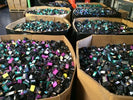
How Ink Cartridges Are Contributing to the E-Waste Crisis
, by Planet Green, 3 min reading time

, by Planet Green, 3 min reading time
 Hundreds of millions of used ink cartridges are disposed of every year. According to the Environmental Protection Agency (EPA), over 2.3 million tons of electronic devices were ready for end of life management in 2010. Five years later, consumption of electronics has increased making the disposal of electronic devices, and accessories a major concern. Each cartridge contains plastics, metals, and toxic materials, making recycling the best environmentally responsible option.
Hundreds of millions of used ink cartridges are disposed of every year. According to the Environmental Protection Agency (EPA), over 2.3 million tons of electronic devices were ready for end of life management in 2010. Five years later, consumption of electronics has increased making the disposal of electronic devices, and accessories a major concern. Each cartridge contains plastics, metals, and toxic materials, making recycling the best environmentally responsible option.Recycling inkjets is the BEST solution
Inkjet cartridges pose a threat to the environment when discarded incorrectly. The following figures demonstrate why recycling is the best option:
What can Businesses and Consumers Do?
The easiest way to reduce the environmental impacts of empty ink cartridges is to recycle them. Ink cartridges can be remanufactured allowing to double their life. Remanufacturing involves cleaning, disassembling used cartridges, inspecting the components, inserting a new core, replacing worn parts like printer heads, and refilling ink wells with manufacturer specification ink.
The process of remanufacturing saves energy and materials because plastics and metals are reused, but most importantly, recycling inkjets reduces the amount of cartridges that ends up in landfills or incineration facilities.
As an industry leader in remanufactured inkjet cartridges, Planet Green, located in the USA, uses in-house built equipment and advanced remanufacturing methods. All the necessary steps are taken to ensure that all the components to make products are properly reused. Ink cartridges can be remanufactured up to 3 times using a majority of original parts making the savings in energy significant.
Get paid for your used cartridges
Many individuals and organizations have used Planet Green Recycle fundraising program to raise funds for their cause. In fact, Planet Green has paid out millions of dollars over the past 20 years to more than 13,000 causes. Planet Green has been able to assist local schools, nonprofit organizations, sports clubs, and religious institutions raise funds for their cause. Planet Green Recycle fundraising program also ensure that the value and importance of recycling inkjets is spread through education and awareness.
The environmental impact of new technologies can be huge, especially when the manufacturing, distribution, and end of life processes are viewed holistically. Recycling inkjets and using remanufactured cartridges is just one of the ways businesses and individuals can reduce their environmental footprint, while also saving money on quality products.

In the battle against plastic pollution, banning plastic bags is often seen as a significant step, though the long term results remain unproven. A closer...

As stewards of the future, it's essential to educate children about the importance of recycling and conservation from an early age. By instilling environmental values...

The Earth stands as a magnificent cradle of life; a testament to the wonders of our universe. Hosting billions of humans alongside trillions of other...

As consumers, the choices we make have a significant impact on the environment. By supporting sustainable brands, we can contribute to positive environmental and social...